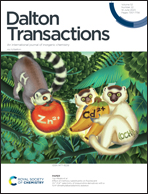A Lewis acid–base paired InBO3 catalyst: synthesis and high selectivity for isopropanol dehydrogenation†
Abstract
Whilst metal borates are well known as optical materials, their potential in solid catalysis has been less investigated. The calcite structured InBO3 was selected as the target borate and was prepared using a solvothermal method. High-resolution transmission electron microscopy and powder X-ray diffraction prove that the material has a nanoparticle morphology with an average size ∼50 nm and high crystallinity. Intrinsic surface oxygen vacancies, which are beneficial to catalysis, were detected using X-ray photoelectron spectroscopy. Lewis acidity and basicity were both observed using NH3-/CO2-temperature-programmed desorption experiments, and the total acid and base amounts were found to be 46.6 and 123.8 μmol g−1, respectively. Catalytic dehydration and dehydrogenation reactions for isopropanol at elevated temperatures were conducted in a fixed bed reactor to evaluate the catalytic performance of InBO3. InBO3 exhibits a high conversion rate (>90.5%) and, most importantly, a high dehydrogenation selectivity (acetone selectivity >92.5%), whilst the optimal acetone yield achieved was 121.3 mmol h−1 g−1cat at 350 °C. This study on InBO3 strongly suggests that metal borates have promising applications in heterogeneous catalysis.



 Please wait while we load your content...
Please wait while we load your content...